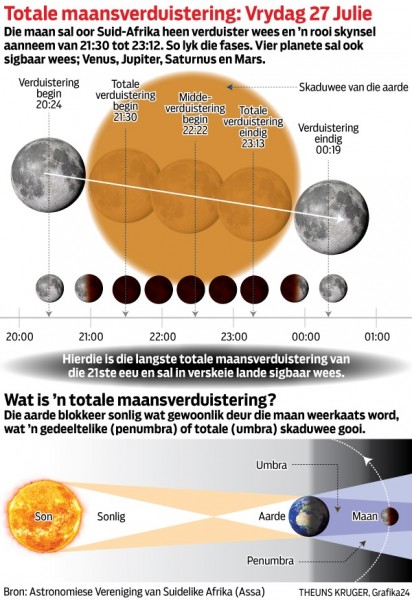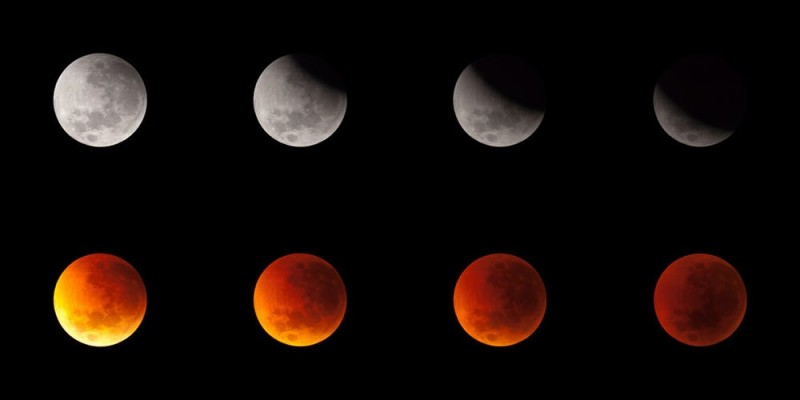Onthou: Kyk hoe verduister die maan
Die langste algehele maansverduistering van die 21ste eeu sal Vrydagaand voorkom en dit sal oor die hele Suid-Afrika te sien wees. So ’n lang en algehele maansverduistering sal nie weer voor 2100 voorkom nie.
Sterrekundiges het uitgewerk presies hoe lank die maansverduistering sal duur: Een uur, 42 minute en 52 sekondes. Die algehele verduistering sal van 21:30 tot 23:13 duur. Die hele gebeurtenis sal egter langer wees.
Die weer gaan ongelukkig nie oral saamspeel nie, luidens die Suid-Afrikaanse Weerdiens se voorspelling vir 20:00 Vrydagaand.
Kaapstad, die Boland en die Weskus: Gedeeltelik bewolk met reën. * Pretoria: Geen reën, geen wolke. * Johannesburg: Geen reën, geen wolke. * Polokwane: Geen reën, geen wolke. * Musina: Geen reën, geen wolke. * Mbombela: Geen reën, geen wolke. * George: Bewolk met reën. * Port Elizabeth: Bewolk met reën. * Bloemfontein: Geen reën, moontlik wolke. * Upington: Geen reën, moontlik wolke. 
In ’n sonsverduistering beweeg die maan tussen die son en die aarde in en blokkeer sonlig op ’n deel van die aarde.
In ’n totale maansverduistering beweeg die aarde tussen die son en die maan in en blokkeer só die maanlig. Wanneer dit gebeur, verander die maan se kleure in oranje tot dieprooi en dit word nie heeltemal donker nie.
Verstrooide straling van die son wat deur die atmosfeer beweeg, baai die maan in dié kleure. Dit is dieselfde straling wat ’n sonsondergang rooi maak. Volgens Space.com sal die maansverduistering so lank duur omdat die maan deur die middel van die umbra (volskaduwee of kernskaduwee) sal beweeg. Meestal is dit so effens meer aan die kant daarvan.
Nog ’n rede waarom dit so lank sal duur, is omdat daar ’n apogee is. Dit beteken dat die maan op dié datum op sy verste van die aarde af is in sy maandelikse wentelbaan. Spesiale geleenthede waarheen mense uitgenooi word, is onder meer:
- Kaapstad: Die V&A Waterkant en die Assa-tak in Kaapstad nooi mense om na die Waterkant te gaan sodra die son gesak het teen 18:00. Daar sal kenners wees om mee te gesels, asook teleskope om deur te kyk.
- Johannesburg: Die Astronomiese Vereniging van Suider-Afrika (Assa) se tak in Johannesburg nooi mense om van 18:00 tot ná die verduistering by die ou Observatorium op die koppie by Gillstraat 18 in Observatory byeen te kom. Daar sal teleskope wees en vuur gemaak word.
- Overberg: Die Suid-Kaapse Astronomieklub nooi mense om op Pearly Beach te kuier.
- Stellenbosch: Die Orion-observasiegroep se kaartjies is ongelukkig reeds uitverkoop.
- Magaliesburg: Daar sal ’n praatjie en teleskope wees by die MelonRouge-restaurant. Dit kos R150 per persoon.
- Pretoria: Rietvlei-natuurreservaat, teen R100 per persoon. Mense kan van 18:00 af by die hek ontmoet.
- Bloemfontein: Die Vriende van Boyden-observatorium nooi mense om van 18:00 af by die sterrewag langs Maselspoort byeen te kom. Toegang is R50 per motor en verversings sal te koop wees.
https://www.netwerk24.com/Nuus/Wetenskap/onthou-kyk-hoe-verduister-die-maan-20180726https://www.netwerk24.com/Nuus/Wetenskap/onthou-kyk-hoe-verduister-die-maan-20180726
Volg dit ook hier: https://weather.com/news/trending/video/watch-longest-total-lunar-eclipse-of-century-live












Comments